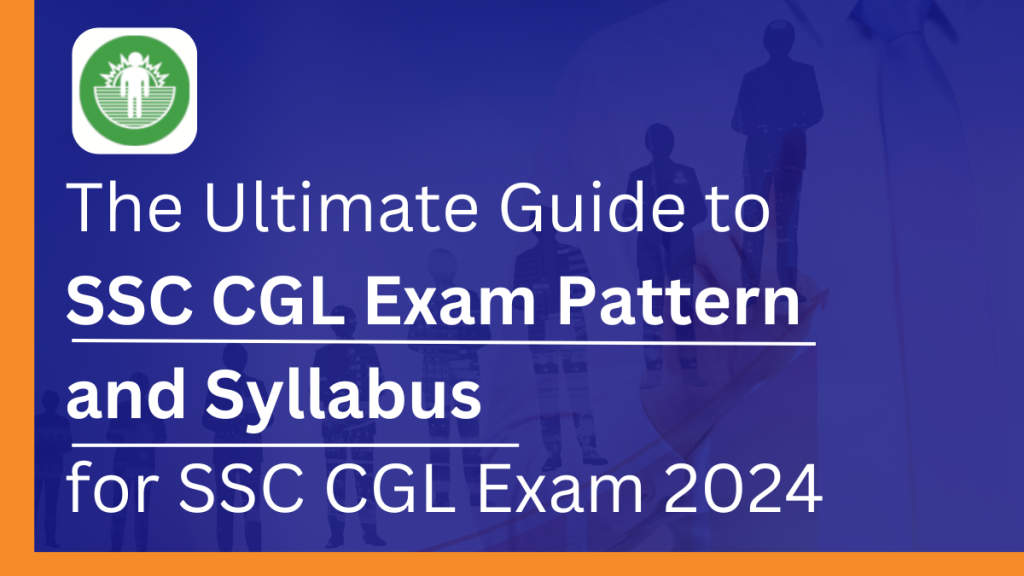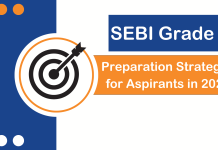The Staff Selection Commission Combined Graduate Level examination, well-known as the SSC CGL exam, is one of the most well-known competitive exams among the people of India. Thousands of aspirants sit for the exam each year in hopes of qualifying it. Clearing the exam opens the gateway to a huge number of prestigious government posts, bringing prospects in different departments, ministries, and organizations of the Indian government. With the growing competition every year, it becomes important to know the SSC CGL exam pattern and syllabus of the examination comprehensively to achieve success.
In this blog, we will deliver a comprehensive guide for aspirants in SSC CGL 2024-from the test pattern to the subject-wise syllabus of the test. Be it your first take at the SSC CGL exam or another try-this guide will lead you through all the intricacies of the examination and provide the needed insight and strategies to ace every stage of the SSC CGL exam.

SSC CGL Exam Pattern
Understanding the structure of the SSC CGL exam is crucial for effective preparation. The SSC CGL exam is divided into two tiers, each serving a specific purpose in evaluating a candidate’s abilities. These tiers are conducted over different phases, and candidates must qualify in each tier to move on to the next.
Tier I: Preliminary Exam
The first stage of the SSC CGL exam is the Preliminary exam. It is a completely objective, online computer-based exam. The SSC CGL Prelims exam has four sections. These sections are General Intelligence and Reasoning, General Awareness, Quantitative Aptitude, and English Comprehension.
Each section has an equal weightage of 50 marks, making the total marks of this stage of the exam to be 200. There is negative marking in the SSC CGL prelims exam. For every incorrect answer, out of the 2 marks assigned to each question, 0.25 marks will be deducted. The total duration of the SSC CGL prelims exam is 60 minutes. The Tier I exam is crucial as it serves as the qualifying stage for Tier II. The scores obtained here are, however, not considered for the final selection.
| SSC CGL Tier I Syllabus | Syllabus | No. Of Questions | Total Marks | Time Allotted |
| General Intelligence and Reasoning | 25 | 50 | 60 Minutes | |
| General Awareness | 25 | 50 | ||
| Quantitative Aptitude | 25 | 50 | ||
| English Comprehension | 25 | 50 |
Tier II: Final Stage
The SSC CGL Tier 2 exam is a computer-based online test that consists of three papers: Paper I, Paper II, and Paper III. Paper I is compulsory for all posts, while Paper II is for Junior Statistical Officer (JSO) candidates, and Paper III is for Assistant Audit Officer/Assistant Accounts Officer candidates.
Paper I is divided into two sessions. The first session is further divided into sections with different modules. The overall topics covered in Paper I of the SSC CGL final exam are Mathematical Abilities, Reasoning and General Intelligence, English Language and Comprehension, General Awareness, and Computer Knowledge. Candidates must qualify in all sections of Paper I.
The second session of Paper I of the final SSC CGL exam comprises of a 15-minute Data Entry Speed Test. The Data Entry Speed Test will not have any marks but will be qualifying in nature. It is an objective type with multiple choice questions and has a duration of 2 hours 30 minutes.
| SSC CGL Tier II Exam Paper 1 (mandatory for all posts) | Syllabus | No. Of Questions | Total Marks | Time Allotted |
| Section 1 | Module I: Mathematical Abilities | 30 | 90 | 1 Hour |
| Module-II: Reasoning and General Intelligence. | 30 | 90 | ||
| Section 2 | Module-I: English Language and Comprehension | 45 | 135 | 1 Hour |
| Module-II: General Awareness | 25 | 75 | ||
| Section 3 | Module-I: Computer Knowledge Module | 20 | 60 | 15 Minutes |
| Module-II: Data Entry Speed Test Module | One data entry task | No marks allotted | 15 Minutes | |
| Total | 150 + 1 data entry task | 450 | 2 Hours 30 Minutes |
Paper II and Paper III are also objective types with multiple choice questions and have a duration of 2 hours each. Paper II consists of questions from Statistics. Paper III consists of general studies from Finance and Economics. The questions in Paper II and Paper III will be set in both English and Hindi. The SSC may conduct normalization on the marks obtained in Tier 2.
| SSC CGL Tier II Exam Papers for Specific Posts | Syllabus | No. Of Questions | Total Marks | Time Allotted |
| Paper 2 (mandatory only for those for candidates who apply for the Junior Statistical Officer (JSO) posts) | Statistics | 100 | 200 | 2 Hours |
| Paper 3 (mandatory only for candidates who have applied for the posts of Assistant Audit Officer/ Assistant Accounts Officer) | General Studies (Finance and Economics) | 100 | 200 | 2 Hours |
For the final selection, the merit list that is prepared is based only on the marks of the Tier II stage of the exam. This is what makes the Tier II SSC CGL exam so crucial. The list for posts that require sitting for Paper 2 or Paper 3 of the SSC CGL Tier II examination will make use of the consolidated marks of Paper 1 and Paper 2 or Paper to preparr the final merit list which will decide who gets selected.
Detailed SSC CGL Syllabus
The syllabus for each topic under the SSC CGL exam has several subtopics and points of study. Preparing for the SSC CGL exam means to be aware of what the nature of the SSC CGL syllabus is. To understand this and gauge the depth of the SSC CGL examination, we will go through each topic of the syllabus in detail.
SSC CGL Tier I Detailed Syllabus
The SSC CGL Tier 1 exam is the first step in your journey toward securing a government job through the SSC CGL. It’s essential to understand the syllabus thoroughly so you can prepare effectively. Let’s break down the syllabus for each section of the Tier 1 exam, which comprises four key areas: General Intelligence and Reasoning, General Awareness, Quantitative Aptitude, and English Comprehension. One key thing to note is that the difficulty level of questions in General Intelligence & Reasoning, General Awareness, and English Comprehension will be of graduation level. For the Quantitative Aptitude section however, the level of difficulty will mimic the matriculation level.
Take a look at the following table that covers the detailed syllabus of the Tier I SSC CGL exam:
| Section | Topics Covered |
| General Intelligence & Reasoning | Analogies, Similarities and Differences, Space Visualization, Spatial Orientation, Problem Solving, Analysis, Judgment, Decision Making, Visual Memory, Discrimination, Observation, Relationship Concepts, Arithmetical Reasoning and Figural Classification, Arithmetic Number Series, Non-verbal Series, Coding And Decoding, Statement Conclusion, Syllogistic Reasoning, Semantic Analogy, Symbolic/ Number Analogy, Figural Analogy, Semantic Classification, Symbolic/ Number Classification, Figural Classification, Semantic Series, Number Series, Figural Series, Problem Solving, Word Building, Coding & De-coding, Numerical Operations, Symbolic Operations, Trends, Space Orientation, Space Visualization, Venn Diagrams, Drawing Inferences, Punched Hole/ Pattern- Folding & Un-folding, Figural Pattern-folding And Completion, Indexing, Address Matching, Date & City Matching, Classification Of Centre Codes/ Roll Numbers, Small &Amp; Capital Letters/ Numbers Coding, Decoding and Classification, Embedded Figures, Critical Thinking, Emotional Intelligence, Social Intelligence |
| General Awareness | Current events and of such matters of every day observations and experience in their scientific aspect, Questions relating to India and its neighbouring countries especially pertaining History, Culture, Geography, Economic Scene, General Policy & Scientific Research |
| Quantitative Aptitude | Whole Numbers, Decimals, Fractions and Relationships Between Numbers, Percentage. Ratio & Proportion, Square Roots, Averages, Interest, Profit and Loss, Discount, Partnership Business, Mixture and Alligation, Time and Distance, Time & Work, Basic Algebraic Identities of School Algebra & Elementary Surds, Graphs of Linear Equations, Triangle and Its Various Kinds of Centres, Congruence and Similarity of Triangles, Circle and Its Chords, Tangents, Angles Subtended By Chords of a Circle, Common Tangents to Two or More Circles, Triangle, Quadrilaterals, Regular Polygons, Circle, Right Prism, Right Circular Cone, Right Circular Cylinder, Sphere, Hemispheres, Rectangular Parallelepiped, Regular Right Pyramid With Triangular or Square Base, Trigonometric Ratio, Degree and Radian Measures, Standard Identities, Complementary Angles, Heights and Distances, Histogram,Frequency Polygon, Bar Diagram & Pie Chart |
| English Comprehension | Candidates’ ability to understand correct English, his/ her basic comprehension and writing ability, etc. would be tested |
SSC CGL Tier II Paper 1 Detailed Syllabus
Candidates who qualify Tier I of the SSC CGL exam will then move on to the next stage of the selection procedure. Paper 1 of Tier II is compulsory for all candidates regardless of the posts they have applied for. Also, as opposed to Tier I, the marks scored in Paper 1 will actually contribute to the final merit list. This means that the marks of Tier II alone will determine which candidates make the cut and go on to become SSC employees.
Following is the detailed breakdown of the Tier II, Paper 1 syllabus of the SSC CGL exam.
| Section | Topics Covered |
| Module-I of Session-I (Mathematical Abilities) | Computation of Whole Number, Decimal and Fractions, Relationship between numbers, Percentages, Ratio and Proportion, Square roots, Averages, Interest (Simple and Compound), Profit and Loss, Discount, Partnership Business, Mixture and Alligation, Time and distance, Time and work, Basic algebraic identities of School Algebra and Elementary surds (simple problems) and Graphs of Linear Equations, Triangles, Quadrilaterals, Regular Polygons, Circle, Right Prism, Right Circular Cone, Right Circular Cylinder, Sphere, Hemispheres, Rectangular Parallelepiped, Regular Right Pyramid with triangular or square Base, Trigonometry, Trigonometric ratios, Complementary angles, Height and distances , Use of Tables and Graphs, Histogram, Frequency polygon, Bar-diagram, Pie-chart; Measures of Central Tendency |
| Module-II of Section-I (Reasoning and General Intelligence) | Semantic Analogy, Symbolic operations, Symbolic/ Number Analogy, Trends, Figural Analogy, Space Orientation, Semantic Classification, Venn Diagrams, Symbolic/ Number Classification, Drawing inferences, Figural Classification, Punched hole/ pattern-folding & unfolding, Semantic Series, Figural Patternfolding and completion, Number Series, Embedded figures, Figural Series, Critical Thinking, Problem Solving, Emotional Intelligence, Word Building, Social Intelligence, Coding and de-coding, Numerical operations |
| Module-I of Section-II (English Language And Comprehension) | Spot the Error, Fill in the Blanks, Synonyms, Antonyms, Spelling/ Detecting Misspelled Words, Idioms & Phrases, One Word Substitution, Improvement of Sentences, Active/ Passive Voice of Verbs, Conversion into Direct/ Indirect Narration, Shuffling of Sentence Parts, Shuffling of Sentences in a Passage, Cloze Passage & Comprehension Passage |
| Module-II of Section-II (General Awareness) | Questions relating to India and its neighboring countries especially pertaining to History, Culture, Geography, Economic Scene, General policy and scientific research. |
| Module-I of Section-III I (Computer Proficiency) | Organization of a computer, Central Processing Unit (CPU), input/ output devices, computer memory, memory organization, back- up devices, PORTs, Windows Explorer. Keyboard shortcuts, Windows Operating system including basics of Microsoft Office like MS word, MS Excel and Power Point, Web Browsing & Searching, Downloading & Uploading, Managing an E-mail Account, e-Banking, Networking devices and protocols, Network and information security threats (like hacking, virus, worms, Trojan etc.) and preventive measures |
SSC CGL Tier II Paper 2 Detailed Syllabus
Paper 2 of Tier II of the SSC CGL exam is compulsory for only those applicants who are applying for the post of Junior Statistical Officer (JSO) posts in the Ministry of Statistics and Program Implementation. Their main work revolves around collecting, compiling, and analyzing data related to various sectors such as economics, demographics, agriculture, health, and education. Using statistical tools, they interpret the data to provide insights that can assist in policy-making, planning, and evaluation.
In case someone has to give Paper 2, the combined marks of Paper 1 and Paper 2 will be used to determine their ranking in the final merit list. The detailed syllabus for the statistics paper of the the SSC CGL exam is as follows.
| Subject | Topics Covered |
| Statistics | Collection, Classification and Presentation of Statistical Data, Measures of Central Tendency, Measures of Dispersion, Moments, Skewness and Kurtosis, Correlation and Regression, Probability Theory, Random Variable and Probability Distributions, Sampling Theory, Statistical Inference, Analysis of Variance, Time Series Analysis, Index Numbers |
SSC CGL Tier II Paper 3 Detailed Syllabus
Like Paper 2, Paper 3 is not mandatory for all SSC CGL applicants. Only those who wish to become Assistant Audit Officer or Assistant Accounts Officer with the SSC will have to give this paper. No candidate will have to give both Paper 2 and Paper 3 because candidates can only apply for one post under SSC as part of their application. Thus, those wishing to become an Assistant Audit Officer or Assistant Accounts Officer need only give Paper 1 and Paper 3 of Tier II. The detailed syllabus of Paper 3 is as follows.
| Subject | Topics Covered |
| Part A: Fundamental Principles and Basic Concept of Accounting | Financial Accounting, Basic Concepts of Accounting like Single and Double Entry, Books of Original Entry, Bank Reconciliation, Journal, Ledgers, Trial Balance, Rectification of Errors, Manufacturing, Trading, Profit & Loss Appropriation Accounts, Balance Sheet Distinction between Capital and Revenue Expenditure, |
| Part B: Economics and Governance | Comptroller & Auditor General of India, Basic Concept of Economics and Introduction to Micro Economics, Theory of Demand and Supply, Theory of Production and Cost, Forms of Market and Price Determination in different Markets, Indian Economy, Economic Reforms in India, Money and Banking, Role of Information Technology in Governance |
Preparation Tips for SSC CGL
Now that you are familiar with the depth of the SSC CGL exam, the next step is to organize yourself to prepare for the upcoming exam. Following is a set of six practical preparatory tips for SSC CGL aspirants based on the pattern and syllabus of the examination:
Be Strong in Quantitative Aptitude
Quantitative Aptitude forms the most important part of the SSC CGL exam. Basic mathematical concepts are tested in every examination. Therefore, begin by perfecting areas like arithmetic, algebra, geometry, trigonometry, and data interpretation. Emphasize on how to know the basic underlying theories and formulae; this would give you a skill of attempting questions in a quick as well as correct manner. Regular practice for different question types is required from each topic. Also, the aspirants must utilize some shortcut techniques as well as tricks in order to solve such complicated questions within the limited time required as the exams have a time constraint.
Develop Your English Language Skills
The section of English Language tests your skills in vocabulary and comprehension. As such, the candidates must go through newspapers, magazines, and good books on a regular basis to improve their vocabulary and grammatical sense for the meaning of sentences. Grammar rules, confusing words, synonyms, antonyms, and idioms need emphasis. Comprehension passages, cloze tests, and rearrangement of sentences are practiced to improve speed and accuracy. Keeping in mind that many questions in the SSC CGL test the shades of word meanings, subtle understanding is what is needed.
Develop Strong Reasoning and Analytical Abilities
The General Intelligence and Reasoning section aims at testing the logical and analytical abilities among the candidates. The section shall also cover questions on both verbal and non-verbal reasoning. The preparation of aspirants should target practice in the fields of puzzles, syllogisms, analogy, coding-decoding, and series completion. Since these questions are to be solved very fast, frequent practice is expected in order to develop a logical reasoning approach to solving these problems. As this section saves time, if attempted well, aim for accuracy at good speed. Utilize previous years’ papers and mock tests to get a feel of the type of questions asked.
Update Your Current Affairs and General Knowledge
The topics covered under General Awareness are very wide-ranging, including current affairs, history, geography, economics, polity, and general science. This vast syllabus can only be covered by keeping yourself in pace with the current news daily, the monthly current affairs magazines, and standard GK books. You can also find all this information in one place with ixamBee’s Beepedia. Making short notes of important events, dates, and facts that can be easily revised at or near the exam will be of great help. The Indian Constitution, economic policies, and recent government schemes are some of the main areas that are highly prone to being asked and should be given special importance.
Practice SSC CGL Mock Tests and Review Previous Year Papers
One of the best ways to prepare for the SSC CGL exam is to take regular mock tests. SSC CGL mock tests will give one exposure to the simulated environment of the final exam, a grip over the time management aspect, and allow aspirants to know about their strengths and weaknesses. At the same time, going over SSC CGL previous year papers will also prove to be a huge asset in preparation as it will help you understand the trend of questions and what the actual exam question paper looks like. You can practice both, the mock tests and previous year papers on a regular basis to familiarize yourself with the SSC CGL exam.
Every time you take a test, set aside some time to analyze your performance-identify the areas where mistakes were made, and focus on improvement. It involves going through the wrongly attempted questions and learning the reasoning behind the correct answer. This will help avoid recurrence of the same mistake. Besides, it would also provide an opportunity to achieve considerable confidence and reduce stress related to the examination through regular practice via mock tests.
Make a Proper Study Plan and Stick to It
A proper study plan is necessary for the SSC CGL exam because of the vastness of its syllabus. Divide the syllabus into manageable fragments and dedicate or assign certain time slots to the various subjects. Now, prioritize the topics according to your strengths and weaknesses, and ensure systematic coverage of each area of the syllabus. Be consistent—rigorously follow the plan you have charted out for yourself. Regular revision to keep all topics fresh in your mind should form a part of the plan. Also, do not forget to keep time for relaxation and hobbies to keep yourself balanced and stress-free during these preparatory months.
Conclusion
As we’ve explored in this guide, the SSC CGL exam is a multi-tiered process designed to assess candidates on various fronts. Preparing for the SSC CGL exam is undoubtedly challenging, but remember that consistent effort and determination can make all the difference. There will be times when the syllabus feels overwhelming or when practice tests don’t yield the scores you hoped for—don’t let these moments discourage you. Instead, view them as opportunities to learn and improve. Stay focused on your goals, and trust the process. Every hour of study, every mock test, and every revision session brings you one step closer to your dream job.
ixamBee, specializes in providing expert guidance and resources for banking exams 2024, ensuring that you are well-prepared for the upcoming bank exams like RBI Grade B, NABARD Grade B, IBPS SO, and more. Our courses align with the bank exam calendar 2024, covering all the essential topics. With a focus on the upcoming bank jobs, our previous year papers, Beepedia, SSC CGL, SSC CHSL, SSC MTS and other mock tests are designed to help you excel in upcoming banking exams.
Also Read:
How To Prepare for SSC CGL Exam?
Five Key Mistakes to Avoid for a High SSC CGL Exam Score
Best online mock test series for the SSC CHSL and SSC CGL















